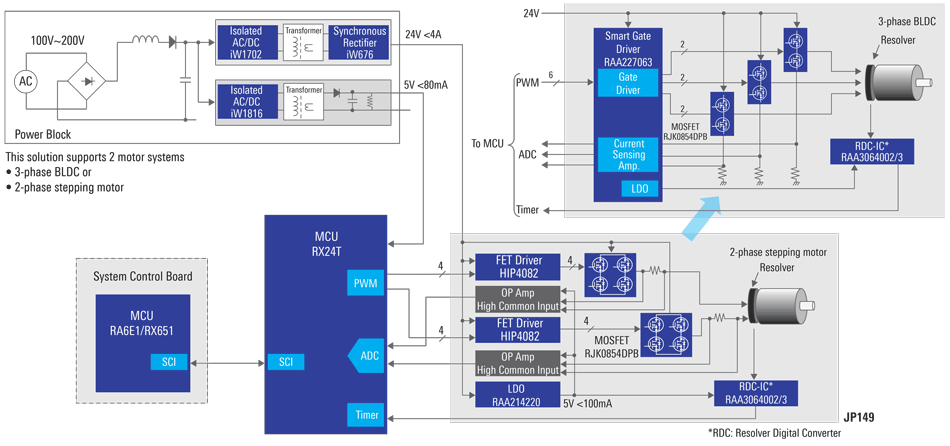Nowadays, under the wave of science and technology, the intelligent development of mechanical equipment has become an inevitable trend, which makes the design of high-efficiency motor control face severe challenges. At the same time, with the significant development trend of electronic products refinement, it is even more difficult to maintain long-term operation and safe and reliable motor control design under the condition of both volume and cost constraints.
In order to shorten the customer's R&D time and ease the customer's R&D difficulty, Renesas has introduced a motor control solution using a resolver, which provides a stepper motor design with a resolver position control function and an optional BLDC motor design, integrated developed a motor with built-in resolver, MCU, resolver, digitizer, motor driver, and power IC for motor and control circuits, not only with extremely high performance, but also in a highly integrated and compact design that can also make it useful in applications with limited volume.

System Block Diagram
MCU selection
This solution adopts dual MCU control of RX24T and RX651/RA6E1. Among them, the RX24T series is a 32-bit microcontroller, which is especially suitable for dual inverter control. Its built-in floating point unit (FPU) enables easy programming of complex inverter control algorithms. This greatly reduces the time required for software development and overall maintenance. The RX24T microcontroller design ensures the highest noise immunity and provides high reliability for any device using an inverter. The RX651 is ideal for IoT devices that require enhanced security, connectivity and HMI capabilities.
stepper motor
This scheme adopts the design of 2 full-bridge FET drivers HIP4082, 1 low dropout linear regulator RAA214220 and 1 resolver-to-digital converter (RDC) IC RAA3064002/3. The HIP4082 H-bridge driver is specifically targeted for PWM motor control and UPS applications. The device operates at a voltage of up to 80V, making it ideal for applications at medium power levels. The device does not contain a charge pump, but has a non-latching level-shift conversion control of the upper-level driver circuit. Such features and specifications are very friendly to applications where size and cost are required.
The RAA214220 low dropout linear regulator features a wide input voltage range of 2.5V–20V and excellent line and load regulation. And integrates a variety of fault protection functions internally, these features make it suitable for battery-powered and USB devices. The role of the RAA3064002/3 RDC IC is to convert the angle analog signal from the resolver into a digital signal for processing by the MCU.
With these devices, stepper motor solutions achieve the following features:
No out-of-step margin is achieved through servo control with resolver position information, maximizing motor torque, reducing motor size, and reducing BOM cost by reducing gears (reducers).
Low noise and low vibration are achieved through servo control that reduces torque ripple. Reduced BOM cost by reducing dampers and downsizing the system.
Power consumption is reduced by controlling torque with the minimum required current. Reduce cooling system costs by reducing heat generation from the motor.
Thanks to these properties, this solution can be used in high-performance motor drives for office automation and industrial applications, such as scanners, multifunction printers and automatic deposit machines.
BLDC Motor Design
The scheme uses the RAA227063 smart gate driver IC and the RAA3064002/3 resolver-to-digital converter (RDC) IC. Among them, the RAA227063 is suitable for three-phase brushless DC (BLDC) motor applications. It integrates three half-bridge smart gate drivers capable of driving up to three N-channel MOSFET bridges supporting bridge voltages from 4.5V to 60V. And has programmable drive strength control. Adjustable and adaptive dead time are implemented to ensure robustness and flexibility
The BLDC motor solution is a high-performance motor drive for automated guided vehicle AGVs, small vehicles, service robots, and motorized bicycle applications, enabling the following benefits:
Fine motion/stop control is achieved through servo control using high-precision position information and high-resolution resolvers.
Suppresses uneven rotation and reduces ripples that cause vibration by improving position resolution and optimizing speed response. It is even possible to suppress vibration/vibration at high speed and quickly move to the target value.
The resolver is made of copper plate or steel plate without precision parts, so it is not easy to break and is durable. The function and performance of the sensor is maintained in any environment such as heat, oil, dust and strong vibration.
The motor control design using resolver combines the stepper motor solution and the BLDC motor solution to bring customers precise control and high motor performance while minimizing customer development time. In the future, Renesas will continue to develop new products on this basis to contribute to the development of motors.

